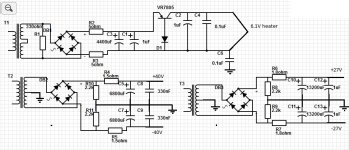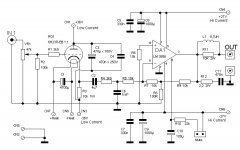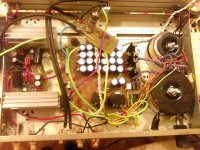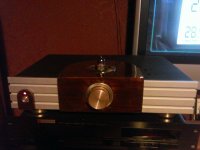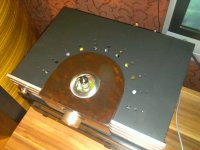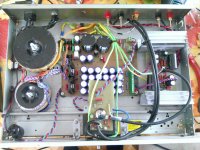I am building a version of the JLTi ( Corsair, can be found on the website of a Russian guy using the nickname Lincor ) with some minor changes to the original schematic. I am new to tubes and have been fighting AC noise for a few days. I am certain it comes from the plate power supply, because:
- preamp signal disconnected - no noise or hum
- preamp signal connected, heater and anode power lines disconnected - no noise or hum
- preamp signal connected, heater connected, anode disconnected - no noise or hum
- source fed directly to the power amp - no noise or hum, plays as normal
I noticed something interesting - if I put a 10ohm resistor on the plate PSU ground, noise increases significantly. This made me replace the 2.5sq. mm gnd cable with 6sq. m and noise dropped considerably. If I connected it after the gnd isolation network ( 10ohm/0.1uF MKP/dual diodes in opposite directions ) the noise would drop even more but is still audible.
If I disconnect the preamp ground noise doesn`t change. It only changes when I tweak the ground of the plate supply so I believe it is a loop.
I did a few modifications to the original schematic and circuit boards. Heater cables are twisted firmly, away of at least 15cm of any other cable and attach directly to the tube socket pins, not like on the original circuit board where they attach to tracks about 10cm long. I removed C3 from the amp schematic ( attached ), not sure what it is for. I also use slightly higher voltage of 40V compared to the original design. Grid stoppers are close to the tube pin, 3K9. Transformers are away of the tube and any cabling, all cables ( except signal lines ) are firmly twisted, signal lines are double shielded with shields soldered to main star gnd on one side. All grounds are of the same lenght cable, 2.5sq.mm copper, and including the center taps attach to a main star ground point which through a disconnecting network ( R/C/D/D) and through a single 6sq.mm. copper cable attaches to chassis, about 10cm away of where the plug earth attaches to chassis. PSU grounds have separate cables going to the main star, each attaches to the negative terminal of the capacitor closest to the diode bridges for each supply. The T3 smoothing caps are an array of 2200uF 35V Elna RE3 with 12 caps per shoulder, T2 ( plate voltage ) caps are single units of 6800uF each, rated at 50V. Resistors are 2W.
I am suspecting a faulty diode as later it appeared i have soldered one of the anode PSU smoothing caps reversed and I believe its been shorted internally but would appreciate a look at the power supply diagram. T2 and T3 bridges have 0.01uF and 0.1uF MKT caps across the diodes, heaters don`t.
I read that large value caps on the anode supply may cause noise, might this be related in some way?
Also, what would be the purpose of a cap that would connect B+ to B- on the tube ( C3/C4)?
- preamp signal disconnected - no noise or hum
- preamp signal connected, heater and anode power lines disconnected - no noise or hum
- preamp signal connected, heater connected, anode disconnected - no noise or hum
- source fed directly to the power amp - no noise or hum, plays as normal
I noticed something interesting - if I put a 10ohm resistor on the plate PSU ground, noise increases significantly. This made me replace the 2.5sq. mm gnd cable with 6sq. m and noise dropped considerably. If I connected it after the gnd isolation network ( 10ohm/0.1uF MKP/dual diodes in opposite directions ) the noise would drop even more but is still audible.
If I disconnect the preamp ground noise doesn`t change. It only changes when I tweak the ground of the plate supply so I believe it is a loop.
I did a few modifications to the original schematic and circuit boards. Heater cables are twisted firmly, away of at least 15cm of any other cable and attach directly to the tube socket pins, not like on the original circuit board where they attach to tracks about 10cm long. I removed C3 from the amp schematic ( attached ), not sure what it is for. I also use slightly higher voltage of 40V compared to the original design. Grid stoppers are close to the tube pin, 3K9. Transformers are away of the tube and any cabling, all cables ( except signal lines ) are firmly twisted, signal lines are double shielded with shields soldered to main star gnd on one side. All grounds are of the same lenght cable, 2.5sq.mm copper, and including the center taps attach to a main star ground point which through a disconnecting network ( R/C/D/D) and through a single 6sq.mm. copper cable attaches to chassis, about 10cm away of where the plug earth attaches to chassis. PSU grounds have separate cables going to the main star, each attaches to the negative terminal of the capacitor closest to the diode bridges for each supply. The T3 smoothing caps are an array of 2200uF 35V Elna RE3 with 12 caps per shoulder, T2 ( plate voltage ) caps are single units of 6800uF each, rated at 50V. Resistors are 2W.
I am suspecting a faulty diode as later it appeared i have soldered one of the anode PSU smoothing caps reversed and I believe its been shorted internally but would appreciate a look at the power supply diagram. T2 and T3 bridges have 0.01uF and 0.1uF MKT caps across the diodes, heaters don`t.
I read that large value caps on the anode supply may cause noise, might this be related in some way?
Also, what would be the purpose of a cap that would connect B+ to B- on the tube ( C3/C4)?
Attachments
Last edited:
A photo of the internals, two thick black cables to the left are double shielded and raised on the top of the radiators level, so 4-5cm above the anode power lines ( twisted red/blue that goes to the tube circuit board ), they also cross at close to 90 degrees. The white twisted pair to the bottom is the heater but it normally goes the other way and close to the bottom of the case, as far away as possible from any other cable. One channel of the power amp is disconnected, ground and V+/V- are not connected ( upper radiator side ). The other white twisted pair is for a LED on the front panel. Caps on the anode bridge are desoldered ( that`s why they look weird ), probed them for fault. When I desoldered them the AC noise went down slightly but not much ( still audible ). Also, forgot to mention in my earlier post, toroids usually don`t radiate as an EI core transformer but to remove them from the possibilities, I put them outside the case as farthest as they could go and there was no change in noise level.
If I disconnect the tube power supply ground completely ( the one I am suspecting in my previous post ), initially there will be zero noise and then the speaker becomes loud with increasing and fast oscilation ( if I leave it for 3-4 seconds it would probably end its life there ) in the 50-60Hz range as it looks.
) in the 50-60Hz range as it looks.
If I disconnect the tube power supply ground completely ( the one I am suspecting in my previous post ), initially there will be zero noise and then the speaker becomes loud with increasing and fast oscilation ( if I leave it for 3-4 seconds it would probably end its life there
Attachments
Last edited:
My build
So, finally had the time to finish the wood trim. I built it with a PS section for the chip using MUR860 diodes bypassed with 0.1uF film caps, a total of 26, 400uF Elna RE3 per rail for the chips plus two extra 1, 000uF Panasonic FC next to the chip pins. My heating is set at 6.1V and I use a 6N23P tube ( single ) which I run at +/- 40V. Coupling cap is Jantzen Cross-cap, the output RL network I did by winding 8 turns of 0.6mm wire on the resistor. DC offset is 26mV on the left channel and 29mV on the right channel ( was higher on the right channel initially ). Pot is a 10k logarithmic. Second photo is with flash so inside cabling is visible.
I like the sound, having built the more common plain LM3886 version before that ( don`t want to start a flame war so won`t mention which schematic it was but it is from a popular seller and is widely discussed on this forum ), this one is at least two classes above. Soundstage is wide and better defined, there is more air between the instruments and vocals sound more natural. What amazed me the most was the transient response, bass impact is tremendous, never heard an amp so far that could drive the tiny Revelators this way.
So, finally had the time to finish the wood trim. I built it with a PS section for the chip using MUR860 diodes bypassed with 0.1uF film caps, a total of 26, 400uF Elna RE3 per rail for the chips plus two extra 1, 000uF Panasonic FC next to the chip pins. My heating is set at 6.1V and I use a 6N23P tube ( single ) which I run at +/- 40V. Coupling cap is Jantzen Cross-cap, the output RL network I did by winding 8 turns of 0.6mm wire on the resistor. DC offset is 26mV on the left channel and 29mV on the right channel ( was higher on the right channel initially ). Pot is a 10k logarithmic. Second photo is with flash so inside cabling is visible.
I like the sound, having built the more common plain LM3886 version before that ( don`t want to start a flame war so won`t mention which schematic it was but it is from a popular seller and is widely discussed on this forum ), this one is at least two classes above. Soundstage is wide and better defined, there is more air between the instruments and vocals sound more natural. What amazed me the most was the transient response, bass impact is tremendous, never heard an amp so far that could drive the tiny Revelators this way.
Attachments
just a quickone,
would it be not better if the voltage gain stage would be tubes, and the output stage would be a voltage follower made from discrete parts ?
or if a high power unity gain stable poweropamp would be used as output stage (if anything like that has even be made) ?
would it be not better if the voltage gain stage would be tubes, and the output stage would be a voltage follower made from discrete parts ?
or if a high power unity gain stable poweropamp would be used as output stage (if anything like that has even be made) ?
- Status
- This old topic is closed. If you want to reopen this topic, contact a moderator using the "Report Post" button.
